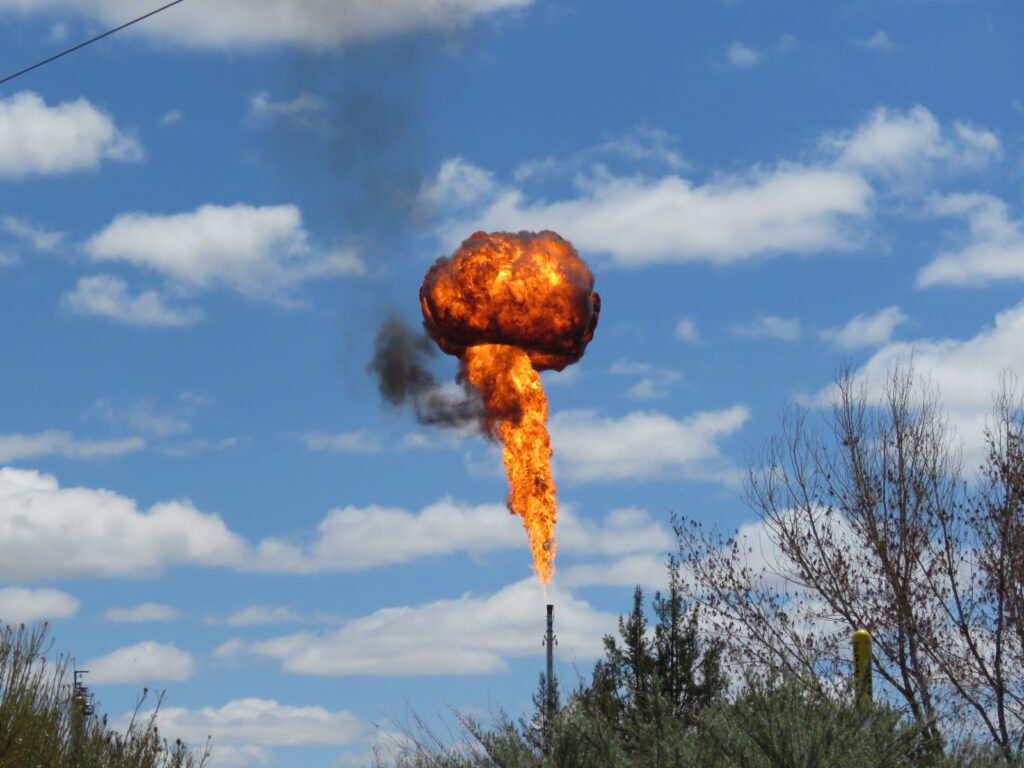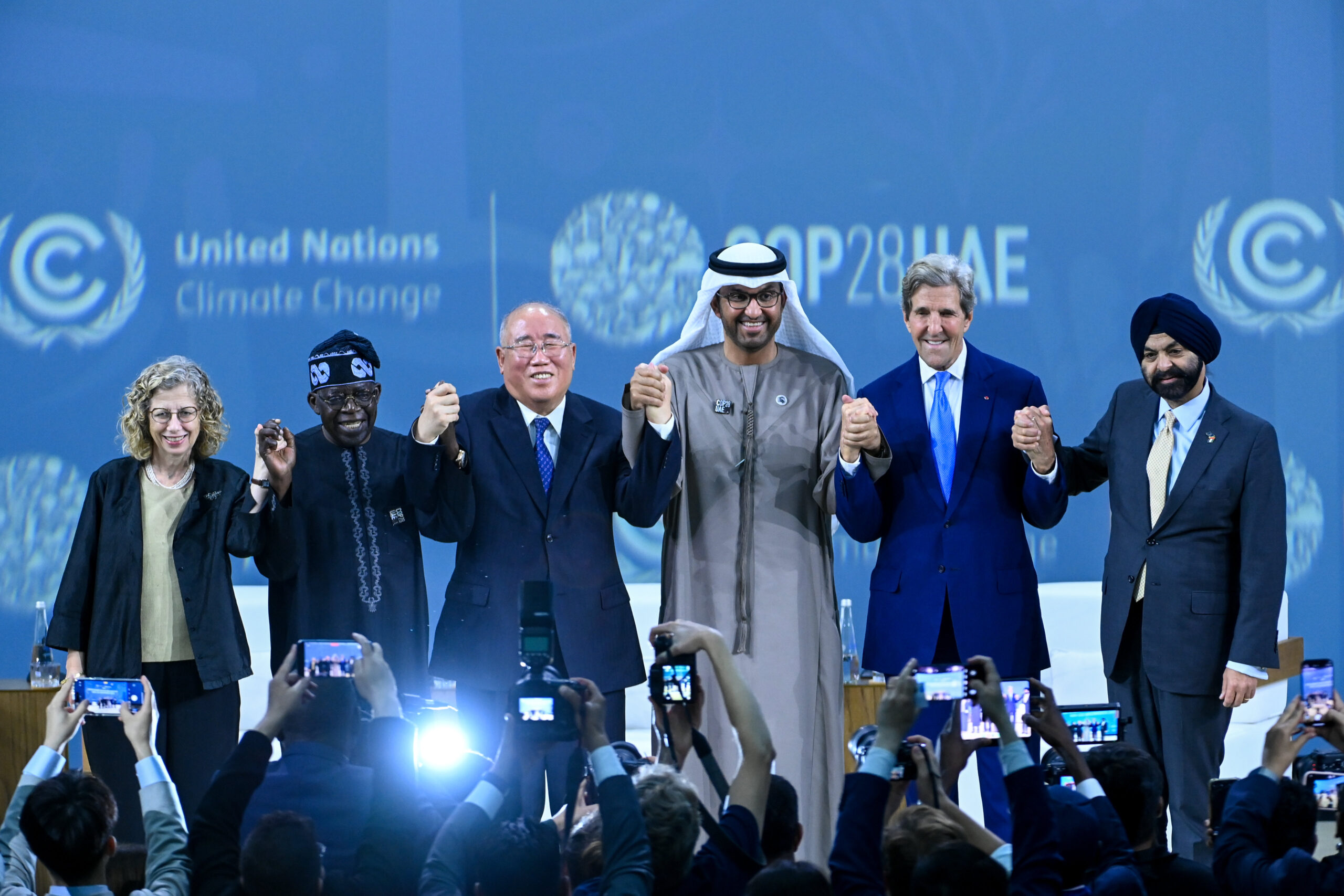

Fifty companies representing over 40% of the world’s oil and gas production signed on to the Oil & Gas Decarbonization Charter, stating their aim to achieve “near-zero” methane emissions in this decade.
“We believe that virtually all methane emissions can be avoided,” the agreement states. “We aim to implement the actions and practices needed to achieve near-zero methane emissions by 2030 on upstream operations under our control and, as applicable, engage with joint operating partners to achieve near-zero methane emissions.”
These changes would not be incremental, according to Fred Krupp, who heads the nonprofit Environmental Defense Fund. In an interview from COP28 with the U.S. television network PBS, Krupp said the average company would have to reduce its methane pollution between 80% and 90% to meet the near-zero target.
Methane is the largest component of natural gas. It can leak from gas pipelines, and oilfield operators sometimes intentionally release waste gas into the air or burn it off, practices known as venting and flaring. One specific aim under the new agreement is to eliminate routine flaring by 2030.

An aerial view of Uruguay’s state-owned La Teja oil refinery, located in Montevideo. Globally, the energy sector accounts for nearly 40% of the methane emissions produced by human activity.
More than half the signatories were national oil companies, including Ecopetrol of Colombia and Petrobras of Brazil. The oil majors that signed on included BP, ExxonMobil, Occidental, Shell, TotalEnergies, and Repsol.
The companies recognize in the agreement that their decarbonization ambitions are voluntary, but vow to facilitate transparency and to measure, monitor, publicly report, and independently verify their performance and progress in reducing their greenhouse gas emissions.
Critics argue that oil and gas companies are not doing nearly enough. In an open letter to the COP28 presidency, more than 300 civil society organizations criticized the industry’s voluntary commitments on emissions as “hollow” and “a dangerous distraction” from the need to phase out fossil fuels altogether.
The energy sector accounts for nearly 40% of methane emissions from human activity, making it the second-largest source after agriculture, according to the International Energy Agency (IEA). Landfill waste is another main source of human-caused methane emissions.
Methane is the second-largest contributor to global warming after carbon dioxide (CO2). While its initial warming effect is around 80 times more potent than that of CO2, methane remains in the atmosphere for a relatively short amount of time—around 12 years, according to the Climate and Clean Air Coalition. Because it is both potent and short-lived, methane has become an increasingly attractive target for reducing emissions quickly.
At COP28—held in Dubai, United Arab Emirates (UAE), from November 30 to December 13—methane was a recurring theme. That was not always the case at climate conferences.

Methane was a recurring theme at COP28. Here, the COP28 President, Sultan Ahmed Al Jaber (third from right), poses for a group photo with high-level representatives of China, Nigeria, the United States, the World Bank, and the United Nations Environment Programme, who spoke during a session on energy. Credit: UNclimatechange.
In fact, John Kerry, the U.S. Special Presidential Envoy for Climate, noted in Dubai that methane was not even discussed during the climate negotiations that led to the adoption of the Paris Agreement in 2015. But the topic is now “front and center,” he said.
Tackling methane is “the fastest, simplest, least expensive, most efficient way of being able to rapidly reduce emissions on the planet,” Kerry said. “This is the place to make the gain and prove that we can win the battle,” he added.
Two years ago—at COP26, held in Glasgow, Scotland—the European Union and the United States launched the Global Methane Pledge, a collective effort to achieve at least a 30% reduction in global methane emissions from 2020 levels by 2030. So far, 156 governments have joined the effort, most recently Angola, Kazakhstan, Kenya, Kosovo, Romania, and Turkmenistan.
China is not part of the Global Methane Pledge, but at a meeting in November, Chinese President Xi Jinping and U.S. President Joe Biden agreed to implement their respective national methane action plans and cooperate on technical solutions to mitigate methane and other non-CO2 greenhouse gases. The two countries, along with the UAE, convened a summit on this subject on the sidelines of COP28 in Dubai.
The goal of curbing methane has become a movement, according to Marcelo Mena, CEO of the Global Methane Hub, a philanthropy-funded nongovernmental organization created to support action on methane.
“In just a few years, the world has undergone a remarkable shift from relegating methane emissions to the sidelines to weaving it in as a central piece of our plan of defense to combat the detrimental environmental and public health impacts of climate change,” he wrote after COP28.
Here are just a few of the other recent developments on the methane front that drew attention in Dubai:
More regulations are focusing on methane. The U.S. Environmental Protection Agency (EPA) announced new standards to sharply reduce methane emissions from oil and gas operations. The Biden administration said the standards will achieve a nearly 80% reduction below expected future emissions without the rule. Canada’s Minister of Environment and Climate Change, Steven Guilbeault, announced stringent new standards as well. “Lowering methane emissions from our oil and gas sector is one of the fastest and most cost-effective ways we can cut the pollution that is fueling climate change,” he said at the 2023 Global Methane Pledge Ministerial, held on the sidelines of COP28. Brazil, meanwhile, said it plans to establish guidelines on methane reduction in the oil and gas sector by the end of 2024.
The European Union (EU) has also adopted its first-ever methane regulations for domestically produced fossil fuels and plans to require imports of oil, gas, and coal into the EU to meet strict methane intensity thresholds by 2030. Katherine Simpson, the EU Commissioner for Energy, said in Dubai that 70% of methane emissions from fossil fuel operations could be reduced with existing technology, and 80% of reductions could be implemented at no net cost.
Methane abatement is attracting more funding. Partners in the Global Methane Pledge announced that over US$1 billion in grant funding for methane action had been committed since COP27. The U.S. State Department said the funding “more than triples current annual grant funding and will leverage billions in project investment.” Philanthropies and the private sector contributed over $637 million of the grant funding, while governments and the European Commission (EC) contributed over $408 million, according to the EC. It said this funding “will support cutting methane emissions across all sectors with a focus in low- and middle-income countries.”
In addition to the grant funding, the EC said, international financial institutions have approved over $3.5 billion in new investments for methane-reduction projects since COP27, including over $1.9 billion from the European Investment Bank and over $372 million from the Inter-American Development Bank (IDB).

A new initiative of the Global Methane Hub will provide $200 million in funding to research ways to reduce methane emissions from livestock.
Reductions in emissions can go beyond the oil and gas sector. The largest source of methane emissions in agriculture come from cattle, sheep, goats, and other ruminants, which digest high-fiber grass or straw through a process called enteric fermentation and release methane through belching. In Dubai, the Global Methane Hub announced a $200 million initiative—the Enteric Fermentation Research & Development Accelerator—designed to address gaps in research and enhance existing efforts to curb methane emissions from livestock. According to a press release, the initiative will include research into feed additives, tools to breed low-methane livestock, immunological studies for a methane vaccine, and ways to lower the cost of measuring methane emissions from livestock, among other efforts. It will be funded through a public, private, and philanthropic partnership.
Advances in data will spur further reductions in methane emissions. The increasing use of satellite technology to verify major releases of methane emissions will help hold emitters accountable, several speakers said in Dubai. As John Kerry put it, “You can run, but you can’t hide.”
Several initiatives are already underway. For example, the United Nations Environment Programme’s International Methane Emissions Observatory (IMEO) has a Methane Alert and Response System (MARS), which issues alerts on methane plumes to the responsible authorities. In addition, the Global Methane Hub, along with IMEO and other partners, has launched a Data for Methane Action Campaign, which aims to deliver increased funding to help governments and businesses address the problems that are identified, including harmful leaks.
Another Global Methane Hub initiative, called the Waste Methane Assessment Platform (Waste MAP), uses satellite monitoring to track and measure methane emissions from landfills.
 View Map
View Map